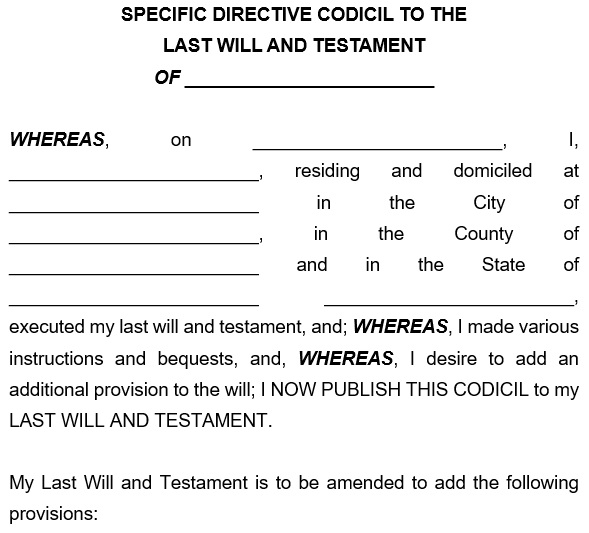A codicil to will form is a legal document that serves as an addendum to a Last Will and Testament. It is generally issued by the Testator or Principal. They are the people who write the Will. Without completely rewriting and replacing the original Will, the Codicil allows the Testator to change their Will.
Table of Contents
Understanding Codicil to Will:
Codicils refer to modifications to existing wills. They are usually issued by the testator in order to make modifications after drafting and sealing the initial Will. When any changes happen to;
- Create the terms of the original Will impossible or
- Coerce the testator into changing the Will. A codicil will be needed to update the existing, initial will legally.
After that, the codicil is attached to the Will. This way, it becomes a formal amendment to the Will itself.
Reasons for using a Codicil to Will Form:
There are a lot of reasons that why the Testator may select to change their Will. Some of the reasons include the following;
- naming a different executor
- bequeathing a certain item to someone who wasn’t added in the original Will
- distributing new assets
- correcting mistakes
- Appointing a guardian
Furthermore, the legal procedure will always involve a codicil since it functions as a legal amendment to the existing Will.
Making sure validity of a codicil to will form:
It should be crafted in line with the state laws and not federal laws for a Codicil to Will to be legally valid. The Codicil should be written, signed, and executed within the State where the original Will was made. For example, some states require that the Codicil be signed in the presence of two witnesses that are not beneficiaries of the Will while some demands that the Codicil be notarized and be attached by an additional affidavit. You may also like Wage Verification Form.
Codicil to Last Will and Testament Form
Codicil to Will Clean Form
Codicil to Will Printable Form
Codicil to Will Template
Specific Directive Codicil of Will and Testament Form
Amending a Will:
Here are the steps that you can follow for amending a Will;
Latest version of the Will
At first, you have to obtain a legal copy of the latest version of the Will. Before writing the will, the testator has to go through the entire Will and write down all the areas they want to modify.
Identify the changes
In the next step, you have to identify the modifications that are supposed to be made to the Will. The testator should take enough time for deciding which items they would like to amend. Moreover, the testator should also determine the sections and language they would like to change.
Compose the codicil
Crating the Codicil to Will is a straightforward process. But, you have to done it with utmost care. The Codicil concerns with the Original will like;
- At the beginning, it should have a declaration concerning the Will
- The date of the original Will
- The Will number
The Codicil also includes the following;
- The Testator’s name
- Address
- Date
- Signature
- A declaration, i.e. how the Testator wants to modify their original Will
Sign the codicil
Likewise a Will, the Codicil is executed. So, the Testator must sign the document in the presence of two witnesses. Also, these two witnesses are not beneficiaries of the Will. The Codicil may have to be signed in the presence of a notary public on the basis of the State’s requirements.
Add to the Will
In the last step, add the Codicil to the Will. The Codicil should be stored with the Will in a safe and secure place. The Testator must also give a copy of all the documents to Will’s executor. Furthermore, let them know where the original copies have been stored.
Conclusion:
In conclusion, a Codicil to Will form is a document needed when any changes have to be made to an existing will. There are different reasons for modifying the Will but the legal procedure to do so will always involve adding a codicil.











